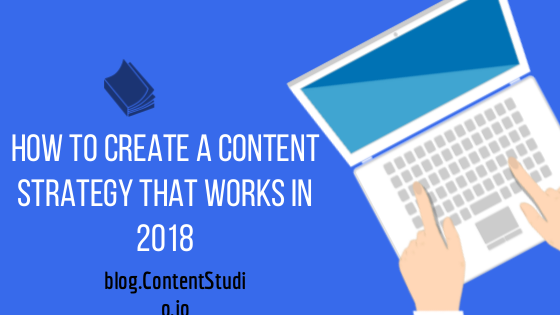Creating content without having a proper content strategy is just like driving Ferrari at 120 MpH blindfolded, for this reason, we have created a complete guide to help you with that so you don’t have to shoot in the dark.
This guide will provide you step by step the whole process of how we create content at ContentStudio with having a whole content ecosystem in place.



If you’re wondering what I mean by a content marketing Strategy, then first go ahead and grab a cup of coffee because I will be going into detail and things are going to get very interesting.
Preface (Things to notice before scrolling ahead)
This is very comprehensive Guide
Indeed, I have written every possible thing to merge and produce a healthy article in order to boost up your marketing plan’s overall health. So, if you haven’t started yet, you will start it before even approaching the conclusion of this guide.
Keep Yourself Focused
As this is quite a detail guide, don’t let yourself lose focus on anything through. It is better to bookmark the page and keep coming back to learn and understand things properly. In fact, share it with your friends and colleagues; discuss with them everything you learn from here.
Let’s dig deeper and take a look at the step-by-step process of creating a content marketing plan that could help you boost every single aspect of your brand:
Write-ups



Step #1: Roll Your Mind, Write down Everything
For me, writing this article isn’t something that could be accomplished within minutes. But if I have prepared myself for what I am going to write, then there are possibilities that I could write it down in minutes because I know what to write.
The same applies to the content marketing strategy. In order to save your time, you need to cover the ground which is necessary and not waste your time finding unnecessary stuff, perhaps you don’t know. So, in order to save your time, this is the important step.
Ask these questions to yourself and then write down the answers:
- Who is the target audience?
- Why it is important for us to create the content?
- What sort of content shall we generate?
- How would that content help us to accomplish our goals?
- What outcome shall we expect?
These questions, if answered correctly, will help you to identify and give sequence to the better next state of achieving the goals. Before planning something, brainstorming is important to bring out all the ideas and then set the target. Once the target is set, aim for it, focus and achieve it. J
The questions above aren’t enough. Figure out more questions based on these basic questions and you might come up with approximately 30 or more questions as subs of the main questions. Then answer them yourself, which would help you to the research level of what you’re trying to do first in order to achieve.
Written everything? You’re set to move to the further steps that could help you on the basis of what you’re in the trying to do – as you’ve mentioned outline.
Is it saving your time now?
Step #2: Clarify Your Goals (Write It Down)



You have to be 100% clear with your intention as you have to be focused to your aim, as discussed in the first step. It means that you need to publish purpose-driven content on your blog or website. Whether you’re creating a content marketing plan for a niche blog or a company’s official blog, the goal, however, should be clear. The upside of clarifying the goal is that your content doesn’t go off the rails. Better is to brainstorm and write down whatever ideas come to your mind. And then decide what your goal is all about.
Let me give you some examples of how other brands and people keep themselves focused on their aim when it comes to the content.
Look at the Long Tail Pro‘s website. They’ve written a questioning-statement above the fold that says, “Are You Looking for an Easy Way to Find the Best Keywords to Rank in Google?” It shows that they’re crystal clear about their prospective audience and they’re expecting people, who need keywords to rank in Google, to visit their website.
Similarly, UberSuggest does something similar. They’ve mentioned, “Get more keywords ideas” on their homepage, which clarifies things for the first-time visitors. This strategy has to be reflected in your content before you start writing and publishing it.
So, if you’re clear about the goal which is the second big step to the content marketing strategy right now. Then, you’re going to find things much easier in the further steps. Don’t forget to write things for your easiness.
Step #3: Identify your Audience



Figure out the target audience to get into the content marketing landscape. Every brand has a different target audience. There would be competitors along the way, but if you master the content marketing skills, you’ll navigate through to reach to your audience.
For example, Filmora.io is a community of video creators, and their website explains it all almost immediately.
Similarly, ExtremeTracking is a tool for website owners to help track the visitors’ statistics. They’ve mentioned it quite clearly on their website’s homepage.
So, the message or headline on your website is pretty important and it comes down to reaching out to the right kind of people that might be interested in your product or service. To make that happen, we need to identify our audience, so that we could create content to attract them.
Step #4: Map out the Content Strategy
It’s imperative to have a content strategy that articulates the type of content you’re going to produce. To layout the content strategy, things like the audience identification and goal setting should have already been done because it won’t be possible otherwise.
For instance, how would you choose a blog post topic when you have no idea about the target market and the intention of the brand? The content strategy typically involves the roadmap of the content creation that helps brands avoid stepping on the wrong foot in their pursuit of prospects engagement, lead generation, and conversion.
Content Marketing Institute defines content strategy as the creation, publication, and governance of useful, usable content.
According to Moz, content strategy is a guideline of how and why your content would be created, managed, and updated.
In other words, a brand must know that what kind of content could help the target audience and why it will impact them positively. When a brand figures this out, the rest of the process gets easier to make that happen.
Step #5: Keep Track Of Your Competitors and Their Efforts



Now as we discussed above; it is important to know what kind of content our audience would love.
In order to figure that out and understand the basic idea of our audience’s needs, we need to keep track of other brands and people to know what they’re offering to their audience and how the audience responds to that. In every field, there are many competitors who might already be working on their content marketing strategy to produce the best for their audience.
For you to startup and give a boost, you need to learn how your competitors are doing it. It could be a little different maybe. For instance, your competitors might not be looking for tip-top earning, but for the audience’s attention. That is what is important, right?
But you need to do something different and more efficient to your audience. As you will begin to learn about your competitors, you’ll learn what they’re offering to the target audience. Then,
- If you learn that your competitors are targeting the business of the audience; it means they’re your direct ones.
- If you learn that your competitors are targeting not the business but just the attention of your audience; it means they’re your indirect competitors.
It is time to ask few questions to yourself:
- What uniqueness could I bring to my content?
- How can I make my brand to stand out with a unique approach?
- What new demands could I come up with?
And many more such questions would click in your mind and you need to answer them. Things will become easier for you.
So, if you’re ready to figure out about your competitors. Don’t forget to take a look at these tools:
These tools will show you which websites are ranking for the same keywords in search engines as you. This would help you to check the difficulty and work according to it. At a glance, you can see who else is getting organic and paid search engine attention to the keywords you might be targeting. This will give you the best idea to be unique on the ground.
Step #6: Do a Content Audit
When we’re talking about the content audit, it is absolutely like taking an inventory of your marketing content. When you take inventory of your marketing content, then there are multiple things that you get as on the list. Let me give you the example of contentstudio’s content inventory. There are two sides of it; offsite and onsite.
Offsite
- Its Social Media Accounts
- The Mailing List Of Subscribers
- Guests Posts (perhaps for backlinking)
Onsite
- contentstudio knowledge base pages
- contentstudio blog
The deeper you’ll get into it, the more information you’ll receive about the marketing content stuff that you need to have first in your inventory.
- You will get all the keywords that you’re ranking in the search engines
- You will get your top blog posts with highest receiving traffic
- The email list
- All the web pages that are live
And so on.
The question might come to your mind that how would you do the content audit?
Don’t worry! There are many useful tools out there that could help you to evaluate the marketing content and how things are going well for you.
Again, SEMrush, Moz is dominating. But the Google Webmasters Tools would also help you to take inventory of your content at the top level.
Step #7: Evaluation of Your Existing Content
In this step, you now need to implement whatever we planned so far. For instance, we have covered the answers before and then we also made an inventory of our content. In this step, our approach will go to the possible state of figuring out the pieces of content which are already complying with our objectives and as we have our inventory, we need to figure out what else we’re going to do.
The thing we need to focus right now is to check which content is already aligned with our objectives and which content we need to focus and modify in order to make it aligned with our objectives. This is going to be our approach now.
So, I have an idea. How about making a chart with the x-axis and y-axis in which the x-axis will be our touch to check whether the content is doing us any favors or not. Check the example of a chart below.
Now in the chart above, you can see which content is highly aligned but the bar shows that it is low performing. At the other hand, the poorly aligned content shows that it is high performing.
Now if you’re thinking what I mean by alignment and performance, let me tell you. The alignment shows how well the work has been done on your side and the performance shows how things are producing the outcome for you according to your alignment. For example, the page views count, likes count, sharing of your content count etc. Got it? Let’s move on!
So, from now, firstly we need to check the content according to the chart that how it is working for us. For example, if there are 100 keywords you’re working to rank with. Sort out which ones are well aligned but top performing, which ones are well aligned and low performing, which ones are low aligned and of course, low performing and which ones are at high ace performance and well aligned. For that, there are multiple tools that can help you through.
Google Webmasters Tools and Google Analytics
And there are many others.
Now it is time to figure out which content is good, which needs to be fixed, which needs to be rejected and what additions shall we apply to our content. Our goal shall be to keep things well aligned and high performing. This is when we will win with our strategy.
Let’s first go for the good content with the good outcome.
It is a helpful act to look for things that are working well for us. The best move is to list everything that is working absolutely perfect for us.
Secondly, let’s sort out what needs to be fixed.
Now for the content that is poorly aligned or low in performance should be our target to fix. Suppose, if there is a post of yours about anything regarding your brand or business, which is not receiving many comments or shares, maybe page views, but only getting likes, shall be taken notice of. We then will sort out what is making it low in performance and what moves shall we apply to fix it. Take notice of it and make a list.
Thirdly, it is time to reject useless content.
If you find something which is not receiving any page views, likes, shares and not even comments. Then maybe it is an outdated version of the content. But it is ok to reject it or even remove it because it will then help you to focus on content which needs to be fixed or added for betterment. I hope it will even help you with your content’s reputation for the search engines.
Fourth, let’s finally decide what ingredients we shall add to boost up our content strategy.
Perfect! As you’ve now figured out and everything with your existing content, let’s roll our mind for the new ideas. What is rolling in your mind for the addition of the new content?
Step #8: Let’s Sort out Effective Content and List Types of Content you’ll be dealing with
Hurray! You’ve audited all your content now.
Before moving onwards, don’t forget to refill your cup of coffee. Well, I remember it! 😀
Identify the major themes of your content. This will even help you to plan for your content promotion.
Ask two questions to yourself:
- What categories or topics of content you will write about?
- Why would your audience favor those categories and topics?
These questions will help you to come up with the theme of your content which will make things quite easier for you to write, design or code the content.
By now, you have figured out all parts of your content; the one which is already good, the one needs to be fixed, the one that is worthless and useless and the one that you’re going to create now.
You’ve done really well so far! J
Now it is time to plan for the production of content which is a whole equation comprises of two parts; one is about the creation of all new content and the other part means to fix the existing content by fine-tuning, updating or optimizing it.
Let’s make a list of the content that we will be dealing with now; the topics and categories (remember?).
- SEO Driven Blog Posts
- Ebooks
- Video Courses
- Infographics
- Interviews
Suppose, the list above is the kinds of content that we will be dealing with, then how about giving each one of them a description to understand the concepts in a much better way?
- SEO Driven Blog Posts; those posts which are specifically set to target the search concepts e.g. specific keywords for organic traffic. Plus, its length could be of approximately 2k+ words. Perhaps intentionally the post is written for gaining comments, organic search traffic, and backlinks too.
- Interviews; to take personal views from those who are experienced with the similar approach as yours. This could help the audience and give them a chance to learn from others who are working on the same ground.
- Ebooks; those documents that are crafted with more than 5k words containing the whole information about the specific topic and delivered in a PDF format. It helps the audience to read it anytime on the go.PDFs are widely used and if you are looking to create PDF documents and then edit them, you might want to check a PDF editor such as JotForm PDF Editor.
Got the idea? In further steps, you will learn how these kinds of content will be generated for the target audience.
Step #9: Figure out the content team and estimate the workflow
PS: This part is absolutely something that happened to me a lot and therefore, I am much interested to share my personal experience with you.
I have crossed the deadline for writing this guide 1 day ago due to underestimation of the workflow. I thought I’ll do it in time, but couldn’t.
So, falling into the trap of underestimation is a really bad idea.
When it comes to content production, you should estimate how long it is going to take to finalize it and who is going to work on the content. You should know about your team and workflow that they could manage, and how the content is going to be created.
First, what will help you is that you should make a list of all those who are going to work on your content.
Secondly, you will have to plan how your workflow is going to be – that is the important part now.
The tricky part is that you will have to figure out how long would it take to find out the content specialists, a designer to design the infographics for you and the cost of all that?
Well, things aren’t going to be very typical because this practice of answering such questions means to identify the creation of the content, which isn’t figured out by us. Isn’t it?
But you have the idea of the workflow and team workers. Let’s move ahead.
Step #10: Figure Out and Estimate the Content Capacity
In the previous steps, we have estimated our workflow and everything else. Now it is time to figure out and estimate the capacity of the content that can be produced in the next span of time.
You should now figure out how much content can be produced by the team of yours confidently. You should now give your team the tasks and see if there is a big list of unfinished tasks by the end of the month. If it happens, change your mind in terms of expectations. If your content is taking more time then decided, then you might have to go for more resources. For example, you may require more in-house content specialist and equipment, or just you may have to outsource and invest more for the high-quality content.
Whatever way you choose, it is about having an idea about the time of content production.
We have made it easier for you in this step as in professional terms; we have to figure out the best way to do something smartly. And here, making a spreadsheet in which you can calculate the time of content production; make columns individually for content type, estimated work hours and estimated work, then simply multiply those hours and you will get the best idea. How is it? Check the screenshot below to understand it better.
Step #11: It is time for editorial calendar
As now we’re aware of content capacity; what and how we’re going to make it. Let’s move on to figure out the time of publishing it.
We’re going to make a map to perform publication of your content assets. This could be the blog posts, PDFs, video courses etc, to be published within or perfectly at the decided time – it could be weeks, months or maybe years. But it is better to keep the time span small, depending on the kind of the content you’re dealing with.
Creating an editorial calendar will help with the overall procedure of publishing content at the time when it is required and should be published. There are multiple tools that could help you to create an editorial calendar to schedule the time of publishing.
You can create a Google Calendar setup and share it with everyone on your team.
You can also create a Trello Board and enable the Calendar View. This is what is even helping us to stay tuned for content publishing schedule.
Step #12: Now Plan Your Content Promotion
We are finally done with everything above. But sometimes, food without salt makes it tasteless. Isn’t it?
Well, the content marketing is incomplete without the promotion of the content. To reap the benefits at its core, the brand that has been busy producing high-quality content for the target audience to help out somehow should also focus on the content promotion now. (We have done everything step by step above)
Let me tell you that ContentStudio is a platform for researching, scheduling and sharing meaningful content with your audience. It’s an integrated social media management platform that also helps you discover the right content for curating it on your blog or social media.
Content curation consists of a compilation of own content and industry’s best content. It plays a vital role in your content promotion strategy. It’s necessary to develop a content promotion plan to cash in on your content creation efforts – the reason is that content marketing remains incomplete without promotion of the content.
It’s Your Turn Now
In the next three lines, I’ll summarize the whole blog post that you’ve just read:
I have simply tried to explain that you need to have a plan that elaborates who you want to reach, what is your end goal, what do you need to achieve that and how would you pursue.
Perhaps, you have got the idea of content marketing strategy now. Well, not just an idea, a whole PLAN I believe. 😉
If you’re excited to execute your content marketing plan, it does show that you have got this.
If you’re still wondering where to begin from, then I’d recommend taking a deep breath and reading this blog post again. Plus, don’t forget the coffee, please!
Now, let’s share your ideas!
I want you to tell me that how you’re going to make your content marketing plan. If you’re already doing it, then what else can you add to this brief tutorial on creating a content marketing plan?
I’ll see you in the comments section. Good Luck!
Wasiq Naeem
Wasiq Naeem is a content and digital marketing veteran who is passionate about his writing. Extensive research and producing high-quality content is just another day at the office for him.






